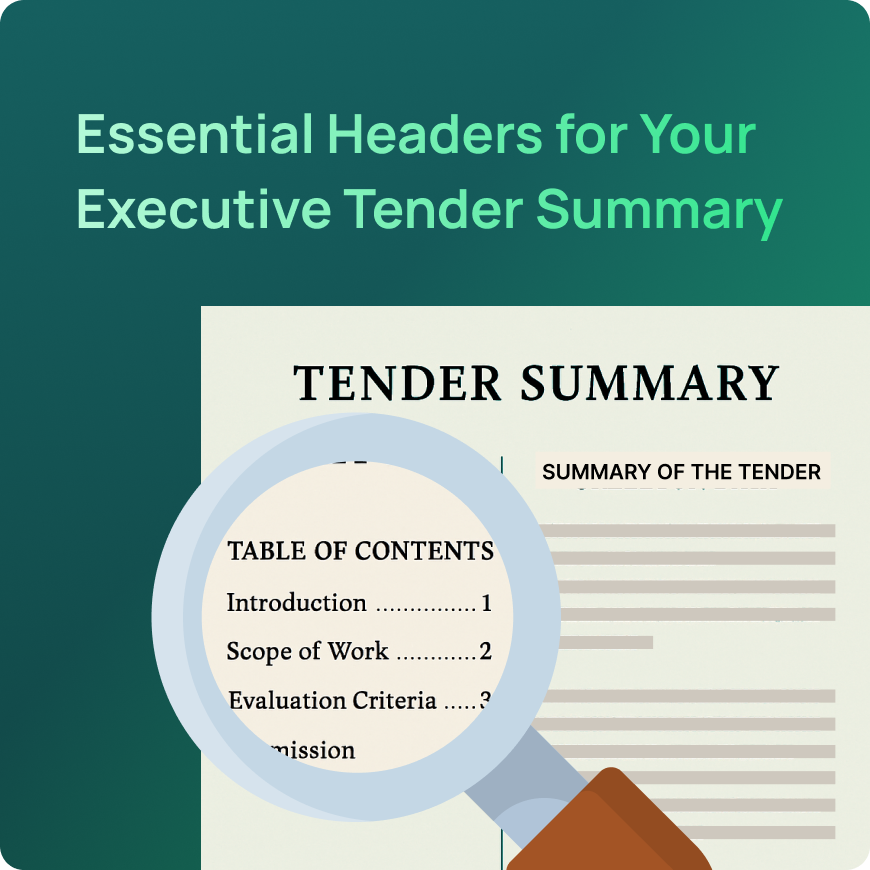Essential Headers for Your Executive Tender Summary
Win more bids with a powerful Executive Tender Summary. Our guide covers key headers, tips for complex Indian tenders, and how AI can speed up your tender analysis.

In the high-stakes world of government and corporate procurement, your bid is your voice. From massive Construction tenders to specialized Energy tenders, the competition is fierce. In India, with thousands of opportunities listed daily on platforms like the Central Public Procurement Portal and the Government e-Marketplace (GeM), how do you ensure your proposal gets the attention it deserves?
The answer often lies in the first document the evaluator reads: the Executive Summary. This isn’t just a formality; it’s your most powerful sales tool. A well-crafted Tender Summary can be the difference between your bid being seriously considered or being relegated to the “no” pile.
This guide will walk you through the essential headers to include in your executive summary, explain its critical importance, and show how modern technology can give you a winning edge in your Tender Analysis.
The Gateway to Your Proposal: Where and Why an Executive Summary is Required
An executive summary, sometimes called a Tender Synopsis, is a concise, high-level overview of your entire tender proposal. Think of it as the trailer for your movie; it needs to be compelling enough to make the audience want to see the whole film.
Why is it so crucial?
Procurement officers and evaluation committees are incredibly busy. They are often responsible for reviewing dozens, sometimes hundreds, of detailed proposals for a single project. They simply don’t have the time to read every page of every submission in the initial stages.
- First Impression: The executive summary is your first—and sometimes only—chance to make a strong impression. It sets the tone for your entire bid.
- Decision-Maker’s Tool: Senior executives and key decision-makers often rely solely on the summary to shortlist potential vendors. A study by Shipley Associates, a leader in proposal development, indicates that many evaluators make a preliminary decision based on the executive summary alone.
- Frames Your Narrative: It allows you to frame your proposal’s core message, highlighting your understanding of the client’s needs and showcasing your unique value proposition before the evaluator dives into the technical details.
This summary is a standard requirement for most formal Requests for Proposals (RFPs), especially for large-scale Indian Tenders, including complex Railway tenders and infrastructure projects.

The Tender Mountain: Just How Long Are Tender Documents?
To fully appreciate the need for a crisp summary, one must understand the sheer volume of information involved in the tendering process. The task of reading tenders is not for the faint of heart.
The length and complexity of tender documents can vary dramatically:
- Simple GeM Tenders: For straightforward goods or services on the Government e-Marketplace, a tender document might be relatively brief, perhaps 10-30 pages.
- Mid-Scale Tenders: A typical municipal or state-level tender for IT services or supplies might range from 50 to 150 pages.
- Large-Scale Construction tenders & Energy tenders: For major infrastructure projects, it’s common to see documents running into hundreds, if not thousands, of pages. These often include extensive technical specifications, architectural drawings, environmental impact assessments, complex legal clauses, and detailed financial requirements.
According to data from India’s Central Public Procurement Portal (CPPP), hundreds of new tenders are floated daily across various sectors. Navigating this volume and the density of each document makes a powerful Tender Summary not just helpful, but essential for both the bidder and the evaluator.
The Anatomy of a Winning Summary: 7 Common Headers to Include
Structure is everything. A chaotic summary reflects a chaotic proposal. Use these clear headers to guide the evaluator through your strengths and win their confidence.
1. Introduction and Project Understanding
- What to Include: Start by clearly identifying the project by its name and tender number. State unequivocally that you are bidding for the project. Briefly articulate your understanding of the client’s core objective.
- Why it Matters: This immediately shows that you’ve done your homework and aren’t just sending a generic response. It aligns your proposal with the client’s goals from the very first sentence.
2. The Client’s Challenge & Our Proposed Solution
- What to Include: In one or two sentences, summarize the problem or need as you understand it from the tender document. Then, immediately present your solution as the definitive answer to that challenge. Focus on the outcome and benefit to the client.
- Why it Matters: This is the heart of your summary. It demonstrates empathy and positions your company as a problem-solver, not just a service provider.
3. Key Differentiators & Unique Value Proposition (UVP)
- What to Include: Why should they choose you over everyone else? List 3-4 bullet points highlighting your unique strengths. This could be your proprietary technology, extensive experience in similar projects (e.g., “Successfully delivered 5 similar Railway tenders in the last 3 years”), a highly qualified team, or a superior safety record.
- Why it Matters: This section directly addresses the competitive nature of the bid. It gives the evaluator concrete reasons to champion your proposal.
4. Proposed Methodology and High-Level Timeline
- What to Include: Briefly outline your approach to executing the project. Mention key phases or milestones. You don’t need intricate details, but you must show you have a credible plan. Include a high-level timeline for completion.
- Why it Matters: This builds confidence that you have thought through the practicalities of delivery and can manage the project effectively.
5. Commercial Synopsis
- What to Include: State the total proposed price clearly and concisely. If relevant, mention any key assumptions or unique financial benefits you offer (e.g., flexible payment terms, long-term cost savings).
- Why it Matters: Transparency is key. Hiding the cost or making it difficult to find can be a red flag for evaluators. Presenting it upfront shows confidence in your pricing.
6. Compliance and Risk Mitigation
- What to Include: Provide a firm statement confirming that your proposal is fully compliant with all the mandatory requirements of the tender. Briefly mention your approach to managing key project risks.
- Why it Matters: This is a crucial assurance for public sector tenders, like GeM Tenders. It tells the evaluator that yours is a low-risk, compliant bid that won’t cause procedural headaches later.
7. Conclusion and Call to Action
- What to Include: End with a confident closing statement. Reiterate your enthusiasm for the project and your certainty that you can deliver exceptional results.
- Why it Matters: You want to end on a high note, leaving a lasting positive impression that encourages the evaluator to move forward with your proposal.

The AI Advantage: Supercharging Your Tender Summary Preparation
The process of reading tenders and performing a thorough Tender Analysis is laborious and time-consuming. This is where Artificial Intelligence is becoming a game-changer for bidding teams.
According to a report by McKinsey on the state of AI, AI adoption is rapidly increasing, with generative AI tools capable of boosting productivity across various functions. For tender management, the benefits are clear:
- Rapid Information Extraction: Instead of manually scanning a 500-page document for deadlines, eligibility criteria, and technical specifications, AI tools can parse the entire document in seconds, extracting and categorising all critical information.
- Automated First Drafts: Modern AI can generate a coherent first draft of your Tender Synopsis. By feeding the AI the full tender document and your internal solution notes, it can create a structured summary incorporating the key headers mentioned above. This draft can then be refined by your subject matter experts, saving dozens of hours.
- Compliance Cross-Checking: AI can perform a compliance check, comparing your proposal against the tender’s requirements list to flag any missing documents or unanswered clauses, significantly reducing the risk of disqualification on technical grounds.
By leveraging AI, your team can move faster, reduce human error, and focus its valuable time on strategy and crafting a truly compelling value proposition, giving you a significant advantage in the competitive landscape of Indian Tenders.